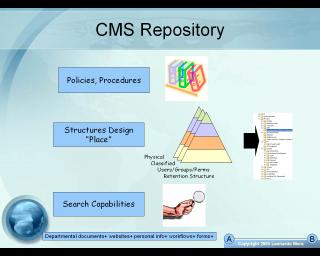What is a Repository?

The following sections, will address specifically how do you implement the concept of structures in a repository. If you are not part of a similar project, you might want to skip to creativity and innovation.
The first thing you need to do when trying to go from one point to another is to define where the initial point is, or A taking A-B. This means creating an information map to know where everything is, and how much effort and materials will consume the task of migrating.
The green section is about identifying the different systems holding your information. Identify possible conflicts with duplicated documents and/or special needs in processes requiring more than one group that are to be migrated at the same time. It can provide valuable statistical information about the growth trends, habits, and current activity in all your systems.
In this diagram we follow the elements in our framework Data-Processes and eventually Collaboration. It is always recommended to have a cleaning and consolidation phase before designing your repository; it can give you a fresh start instead of trying to do it later down the road.
After many implementations is safe to say you will need a strong mandate for this sections to be carried on by your employees. So do not be afraid of asking for this mandate to your CEO or president because this is where leading the way makes a very important fact for the project to succeed.
What I am recommending in this diagram is to have a repository first and then your business processes. Why? Because many business processes may require you to have the repository at hand prior to implementation plus it makes it easier for you to do it while you are doing the repository design first.
In my experience I have found out that some groups (I wont name anyone) have the expectation that a consultant will come with a magic formula to convert the mess they have into something clean and pristine. I had the sense that for some reason they think "one solution fits all" will work in their company. Another type of thinking is asking consultants who else has the same solution or implementation. In reality, these projects are each very different to implement because each company or institution is different, how? in the way they conduct business, the way they store information, in their culture. What you need is to assess each organization and come up with a plan based on the assessment and not from some past experience that seemed to work which is important but it cannot be assumed will work for everyone.
What is a repository?
What is exactly a repository? From the dictionary we read “a facility where things can be deposited for storage or safekeeping”. In technology, a repository is a central place where you can store a variety of objects. One requirement is that the policies and procedures you envision for your company in the digital age need to be clearly defined. Now to the question –Do we make it centralized or distributed? To make thinks simple to manage, you want to centralize, but if you have multiple locations (As a multinacional company does), then you need to combine it with some sort of distribution, so that each location can access rapidly your data. So my take is that the solution must meet both schemes but not at the same levels. The other issue with central repositories is that not every one is online all the time (e.g. Airport-airplane, train) or at least not today, maybe in the short future yes as we see these areas been converted into online hubs.
As it was said in the first section, policies and procedures are a must for you to develop correctly a repository so make sure you have them (they do not have to be complete and extensive) before going any further. I strongly recommend automating those policies.
The structures in a repository can be divided into 3 groups.
Physical Classification, Views, Permissions.
Permissions can be further subdivided in Users, Groups and Roles.
The way we find what we are looking for relies heavily on how good your search technology is combined with how flexible is the tool to handle the results in different ways. I call it the FIND engine. Combining search results with spreadsheet functions gives you a lot of power. Imagine having results from Google or other search engine in a spreadsheet format, where you can sort, expand, filter, etc. Those familiar with Excel and working with this layout, would understand the kind of power I am referring to. The problem with search, is that not all “High quality” pages are always in the first batch of results. And depending what you are looking for, this method might help you greatly I finding what you are looking for.

0 Comments:
Post a Comment
<< Home